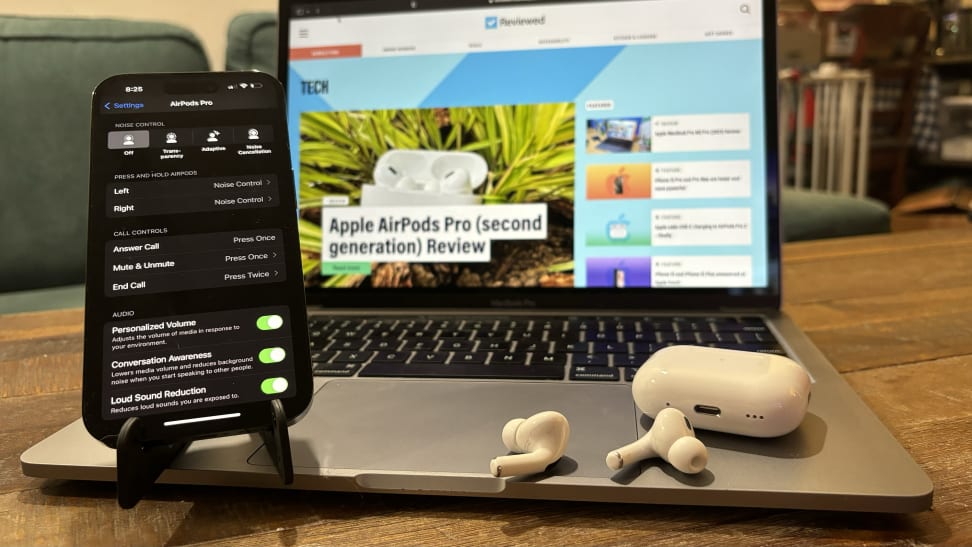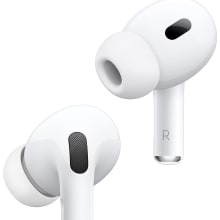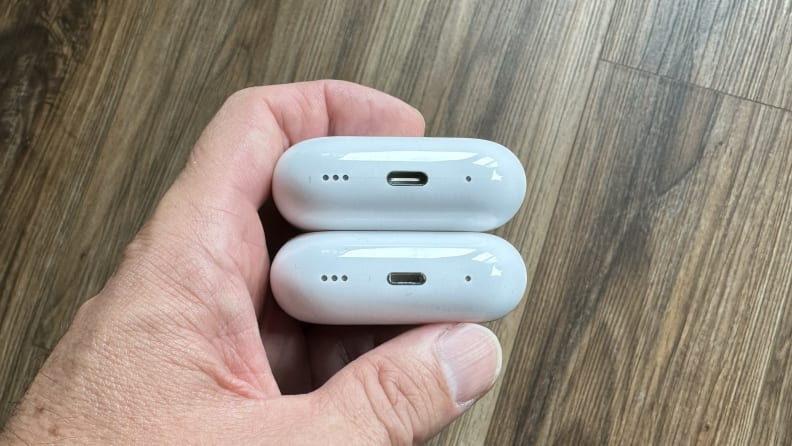Hands-on with iOS 17 and Apple AirPods Pro 2 with USB-C
Impressions from our week with the new iOS and AirPods Pro 2
 Credit:
Reviewed / John Higgins
Credit:
Reviewed / John Higgins
Recommendations are independently chosen by Reviewed's editors. Purchases made through the links below may earn us and our publishing partners a commission.
Back at WWDC in June, Apple announced the upcoming iOS 17 software update that promised to bring some new functionality to the AirPods Pro 2. Then just last week it announced a new version of the second generation AirPods Pro. We’ve had the chance to spend some time with both over the past few days to give them a test drive. Here’s how those new performance upgrades will affect your AirPods when your iPhone installs the new update, and a closer look at the AirPods Pro 2—and if the new ones are worthy of a purchase.

The Apple AirPods Pro 2 deliver incredible noise canceling, excellent sound, and are the best option for Apple users.
Preorder at AmazoniOS 17 AirPods features and performance
Improved Adaptive Audio
Apple has always handled transparency mode as good, if not better, than its competitors. It sounds exceptionally natural with only a slight boost to treble frequencies, that I often forget I’m wearing them in that mode. Apple has now taken the next step in Transparency Mode’s evolution, blending it with ANC to offer Adaptive Audio.
Apple isn’t the only brand to include some form of adaptive noise cancellation to its earbuds—Sony, for instance, links its adaptive ANC to activity (sitting, walking, etc)—but it works more seamlessly than competitors. The sudden blast of water from the kitchen sink when washing my hands gradually sounds more subdued and becomes a background noise instead of the star of my auditory world.
The adaptive timing is what makes it feel convincing and natural. I spent years as a sound editor for films and an important aspect to make sound seem real and unobtrusive is how it fades and blends into everything happening around it. If the fade is too fast or too slow, our attention is naturally drawn to it. Adaptive Audio implementation with iOS 17 sits in the sweet spot, adjusting at the right speed to sound seamless. It’s not perfect, mind you. There were a few times that the ANC was slightly more aggressive in one ear bud than the other, which was discombobulating. But it didn’t happen often and was only for brief seconds when it did.
Apple’s take on conversation awareness
Another feature that’s already being offered by competitors and is now making it to the Apple AirPods Pro 2 is Conversation Awareness. Make a loud enough noise—such as saying “Excuse me?”—and music diminishes in volume as the AirPods transition into transparency mode to allow you to have a conversation. In theory, it’s a great way to keep you connected to the people around you while still having your privacy. But as with every implementation of this I’ve heard so far, it’s only for very specific people—namely, quiet ones.
If you have the habit of singing along to your music, or talking to yourself, or you have a cough, Conversation Awareness has the potential of turning on. I started singing along to the acoustic version of “Everlong” a bit too enthusiastically, engaging Conversation Awareness (and making me a bit self-conscious about my singing volume, even with nobody around). I’m sure in time I could learn the threshold Apple set, but I honestly don’t have that sort of patience.
Personalized volume control
Of these three new AirPods functionality updates, this is potentially the most interesting. The idea is that, through machine learning, the AirPods learn your volume preferences over time and adjusts the volume to the sound around you, fine-tuning your listening experience.
Volume adjustments were subtle in my time with it—perhaps the machine learning needs additional time for a more pronounced effect. The most benefit will likely come as Personalized Volume works alongside Adaptive Audio. When we can hear our surroundings, we all have the tendency to turn up the volume, as it needs to compete with the environment. Then when ANC is enabled, that same volume level is unnecessarily high. Personalized Volume adjusts the volume to save our ears.
A few other improvements
While Adaptive Audio, Conversation Awareness, and Personalized Volume are the big three features with iOS 17, there are a couple more noteworthy mentions. Improved Automatic Switching is in the updates list for those of us with multiple Apple devices, and I experienced less frustration with switching on iOS 17 than I have with previous iOS versions.
There’s also new quick mute/unmute controls when on calls. And while the improvements we’ve listed until now are for the AirPods Pro 2, the mute controls can be found across the audio line, including both generations of AirPods Pro, the 3rd-generation AirPods, and the AirPods Max.
Is it worth upgrading to the new USB-C AirPods Pro 2?

The only physical difference between the two Apple AirPods Pro 2 is the charging port on the case.
With a cursory glance, the new USB-C case and AirPods therein look identical to the Lightning version of the AirPods Pro 2 that came out in 2022. Visually the only difference is the USB-C port on the bottom of the case. It’s nice to see Apple finally adopting USB-C, and it means Apple’s current-gen of products are fully in the USB-C ecosystem. Its laptops have had USB-C for a while, and both the regular iPhone 15 and iPhone 15 Pro versions that are now available for preorder will have the port as well. I’d like to say this is due to Apple seeing the light, but it’s due to USB-C requirements put in place by the European Union for all device manufacturers. Still, whatever the reason, I’m glad it’s finally come to pass. (And thanks, Europe.)
Apart from visuals, the USB-C AirPods Pro 2 also have improved dust resistance (IP54, up from IPX4) and will be able to deliver lossless audio to the Apple Vision Pro with ultra-low latency. Not having a Vision Pro on hand, we were unable to test this functionality. While this will only affect a small percentage of AirPods Pro 2 users, it’s an interesting sign of where things could be headed. There aren’t any details of how Apple is accomplishing this (proprietary technology, and all), but as pointed out by a colleague, we expect it’s at least partly due to the close proximity of the headset and the earbuds when in use together—and probably the reason we’re not seeing that ultra-low latency lossless audio with the iPhone 15 models.
Probably the most disappointing news to come out of this is for existing AirPods Pro 2 owners. There currently is no way to purchase the new USB-C charging case to use with AirPods that came in a Lightning case—and it’s likely to stay that way. I also expect that if you have any problems with your AirPods Pro Lightning case and bring it into the Apple Store for replacement, you’re likely to get a Lightning case back, and not the new USB-C case.
If you’re already the owner of a pair of AirPods Pro 2 earbuds should you sell them off and pick up a USB-C version? The new charging port and improved dust resistance is a nice boon, but I don’t think it’s worth the hassle of getting rid of your old pair. The hefty functional goodness that comes with iOS 17 will work with either version of the AirPods Pro 2, and those are the real story.
For those that haven’t yet bought the AirPods Pro 2, then now is the time. Just make sure the version you’re getting is the USB-C one.

The Apple AirPods Pro 2 deliver incredible noise canceling, excellent sound, and are the best option for Apple users.
Preorder at Amazon